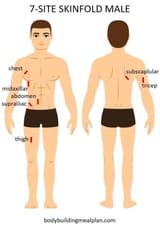>>76464442
DEXA scan is the gold standard for body fat percentage. Its the most accurate way to measure bodyfat. Downside is you need to have access to a DEXA scanner and they usually aren't cheap, and you're giving yourself a small X-Ray dose every time you get scanned. Not something you should be doing weekly to track progress, more like maybe once every 6 months.
After DEXA is the caliper method, upside is its cheap, calipers cost next to nothing, doesn't expose you to anything harmful, and can be done at home. Downside is you'll need someone else to measure some of the points like your back, so hopefully you've got someone around you to help you with that, and pinching your skin to get a good reading can be a little uncomfortable. And the accuracy is kinda dependent on the person taking the readings, if they're a retard you'll get retarded results.
Next down is just looking at pictures and guessing. Which tends to be better than even navy method. 30+%, 25%, 20%, 15%, 10% all look pretty distinct and most of the time we're just trying to ballpark our bodyfat% anyway. If you look like you're 30% you're probably roughly 30%, if you look like you're either 30% or 25% you're probably somewhere between. Its not foolproof but for most fatties its all you need.
Next down is navy method, you measure your waist and neck throw it in a calculator and it gives you a number. This number is usually in the correct ballpark, but if you've got an unusual anatomy it can be thrown off pretty easy (thick neck, thin waist, or vice versa).
Next down are any of the various impedance scales, handheld/smartscale/smart watches, they're overpriced bullshit and give a reading that isn't even remotely accurate. Don't trust these at all, waste of time and money.
4chan Search
1 results for "22e941e20f6f7156cf5ee0aa65b28e5a"
